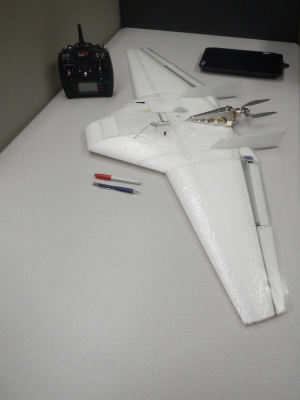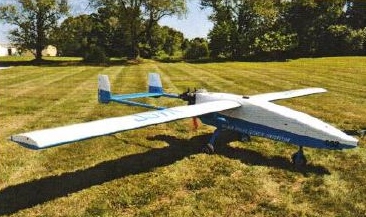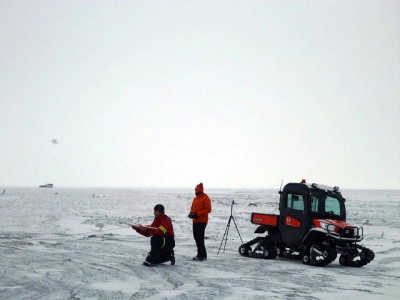ARM Aerial Facility’s Lofty Goal: Collect Crucial Arctic Climate Change Data with Unmanned Aerial Systems
Published: 28 March 2016
ARM bolsters aerial data collection capabilities with new aircraft, instruments for 2016

Concerned about rapid climate change in the Arctic, the U.S. Department of Energy’s (DOE) Atmospheric Radiation Measurement (ARM) Climate Research Facility is procuring a fleet of unmanned aerial systems (UAS) to expand the scope of climate research activities on Alaska’s North Slope and provide data to enhance the accuracy of numerical climate models.
In a recent article in Eos Earth & Space Science News, entitled “Unmanned Platforms Monitor the Arctic Atmosphere“, five ARM co-authors briefly outlined the history of aerial data collection at Oliktok Point, Alaska, noting that the ARM Aerial Facility (AAF) began using tethered balloons there in 2004, a practice that grew in popularity as technology became less expensive. On the ground, ARM also deployed its third Mobile Facility (AMF3) at Oliktok Point until at least 2019 to collect more conventional atmospheric data.
Costs are also coming down for UAS technology. Small units called DataHawks developed by the University of Colorado-Boulder (CU) were tested at AMF3 in 2015 and will be tested a second time by scientists in April 2016 during the Evaluation of Routine Atmospheric Sounding Measurements Using Unmanned Systems (ERASMUS) campaign.
At DOE’s Pacific Northwest National Laboratory, Beat Schmid, manager of the ARM Aerial Facility (AAF) and co-author of the Eos article, reports that the facility has acquired four of the CU DataHawk UAS units and will test them in summer 2016 at AMF3.
“We received the DataHawks at the end of December,” Schmid reports. “They are essentially a small flying wing with a wing span of about a meter. We have full FAA approval to test them at altitudes up to 400 feet—enough for the training—at a site near Pendleton, Oregon.”
Between March 1 and 4, AAF pilots flew training flights with 3 of the DataHawks 39 times for a total of 6 hours at the Pendleton site. Three of these flights were conducted 100 percent on autopilot from take-off through landing, Schmid notes.
Three Campaigns Set

“We are also requesting approval to test them up to 6,000 feet at Pendleton before taking them to Oliktok Point in June, July, and August 2016, where we will fly them in a DOE-managed restricted area that extends to 7,000 feet,” Schmid adds. “During those months, we are scheduled to launch three campaigns for a total of seven weeks.”
While DataHawks can carry a very small instrument payload, the AAF recently received ARM Facility funding to acquire a TigerShark XP, a mid-size UAS developed by Navmar Applied Sciences Corporation that carries up to 100 pounds of instrumentation, according to Schmid. “The goal is to accommodate sophisticated scientific payloads. Initially, we plan to carry a number of baseline instruments in the TigerShark for meteorology, radiation, aerosols, and for gathering some cloud information.”
Mid-size UAS Coming

“We went through a competitive bidding process” that included the aerial vehicle and a ground control station—both hardened for Arctic conditions, as well as spare parts and training for the pilots and maintenance crew, according to Schmid.
“I’m really happy. We never thought we could afford a platform of that capability since cost was the real limit,” he explains.
“We’ll receive the TigerShark in January 2017 and our pilots and maintenance staff will be trained at the factory. Before going to the Arctic, we will conduct engineering and training flights with increasingly complex payloads in Pendleton in 2017 and may also look into training in local restricted areas where we can fly higher. This capability will be part of the ARM Aerial Facility and it will eventually be opened up for ARM user proposals.”
# # #
The ARM Climate Research Facility is a national scientific user facility funded through the U.S. Department of Energy’s Office of Science. The ARM Facility is operated by nine Department of Energy national laboratories, including the Pacific Northwest National Laboratory, which manages the ARM Aerial Facility.
The ARM Climate Research Facility is a DOE Office of Science user facility. The ARM Facility is operated by nine DOE national laboratories, including .
Keep up with the Atmospheric Observer
Updates on ARM news, events, and opportunities delivered to your inbox
ARM User Profile
ARM welcomes users from all institutions and nations. A free ARM user account is needed to access ARM data.


















